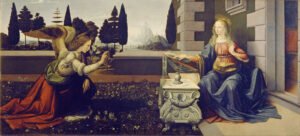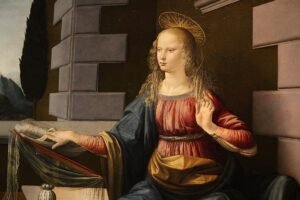Unlocking 11 Hidden Mysteries of The Annunciation by Leonardo da Vinci

What was the purpose of the Annunciation by Leonardo da Vinci?
“The Annunciation by Leonardo da Vinci depicts the moment when the archangel Gabriel appeared to the Virgin Mary to announce that she would bear a son, who would be the Son of God. The Annunciation by Leonardo da Vinci, created in the early 1470s, was commissioned by the monks of the Florentine monastery of San Bartolomeo degli Olivetani, and it was intended to serve as an inspiration for meditation and devotion.
Da Vinci’s portrayal of this divine event is marked by his signature technique of sfumato, which creates a sense of ethereal luminosity. The painting features a rich color palette, intricate detail, and a sense of balance and harmony that perfectly captures the serenity of the moment.
Why is the story of the Annunciation so important?
The story of the Annunciation is one of the most important events in Christian theology, marking the beginning of the fulfillment of God’s promise of salvation. It is believed that Mary’s acceptance of the angel’s message and her submission to God’s will opened the way for the redemption of humanity through the birth of Jesus Christ.
In The Annunciation by Leonardo da Vinci, Da Vinci captures the humility and obedience of the Virgin Mary, who bows her head in submission to the divine message. The archangel Gabriel, on the other hand, is depicted in a posture of authority, his wings and robes suggesting his divine nature. The painting serves as a reminder of the power of faith, and the importance of submitting oneself to God’s will.
The Annunciation by Leonardo da Vinci is a masterpiece of religious art that captures the essence of a pivotal moment in Christian history. Its purpose was to inspire meditation and devotion, and its significance lies in the portrayal of the humility and obedience of the Virgin Mary, and the authority of the archangel Gabriel.
Da Vinci’s use of sfumato creates an ethereal luminosity that perfectly captures the serenity of the moment. This painting is a testament to the power of faith and the importance of submission to God’s will, and its legacy continues to inspire and captivate art lovers and religious scholars alike.
How old was Da Vinci when he painted The Annunciation?
The Annunciation by Leonardo da Vinci was painted when he was in his early twenties. Born in 1452, he began working as an artist’s apprentice in Florence at the age of 14. He continued his education under the tutelage of Andrea del Verrocchio, a renowned artist who trained him in painting, sculpting, and drawing.
It was during his apprenticeship that he painted “The Annunciation,” which is one of his earliest works. Despite his young age, Da Vinci’s talent and creativity are evident in the painting, which is now considered one of his most significant contributions to Renaissance art.
What techniques did Leonardo da Vinci use in the Annunciation?
Da Vinci was a master of many artistic techniques, and “The Annunciation by Leonardo da Vinci” is no exception. One of the most notable techniques used in this painting is sfumato, which means “smoky” in Italian. This technique involves using subtle gradations of light and shadow to create a soft, hazy effect, giving the painting a sense of depth and realism.

Da Vinci also used chiaroscuro, which involves the use of strong contrasts between light and dark to create a sense of drama and depth. This technique is especially evident in the painting’s central figure, the angel Gabriel, whose face is bathed in light while his robes are draped in shadow.
In addition, da Vinci employed the technique of atmospheric perspective, which involves creating a sense of depth and distance by blurring the outlines of objects in the background.
What are 4 important things that Leonardo da Vinci did?
- Experimentation – Da Vinci was a curious and experimental artist who was always trying out new techniques and ideas. He was never satisfied with his work and was always striving to improve and push the boundaries of art.
- Attention to detail – Da Vinci was known for his incredible attention to detail. He studied the human body, nature, and the world around him, carefully observing and documenting every detail. This attention to detail is evident in “The Annunciation by Leonardo da Vinci,” where every element of the painting is carefully rendered and full of meaning.
- Mastery of multiple disciplines – Da Vinci was not just a painter but a polymath who excelled in many disciplines, including engineering, anatomy, and architecture. His knowledge of these fields influenced his art and made him a true master of his craft.
- Humanism – Da Vinci was a humanist who believed in the power of the individual and the potential of human beings to achieve great things. This belief is evident in his art, where he portrays the human form with incredible realism and sensitivity.
The Annunciation by Leonardo da Vinci is a masterpiece of art that showcases the artist’s incredible talent and skill. His use of techniques such as sfumato, chiaroscuro, and atmospheric perspective creates a sense of depth and realism that is unmatched in the art world.

Furthermore, his experimental nature, attention to detail, mastery of multiple disciplines, and humanistic beliefs all contribute to making him one of the most significant artists of all time.
What are 3 things Leonardo da Vinci is known for inventing?
Leonardo da Vinci was an Italian artist, inventor, and scientist who lived during the Renaissance period, from 1452 to 1519. He was a true polymath, known for his immense talents in various fields of study. Leonardo’s genius lay in his ability to combine his scientific and artistic pursuits seamlessly, creating a unique and unprecedented approach to creativity.
Now, let’s explore three things that Leonardo da Vinci is known for inventing:
- Flying Machines: Leonardo was fascinated with the idea of flight and spent a considerable amount of time studying birds to understand the mechanics of their wings. He designed several flying machines, including the ornithopter, which mimicked the flapping wings of a bird, and the glider, which relied on air currents to stay aloft.
- Military Weapons: Leonardo also had a keen interest in military weaponry and designed several innovative machines for use in warfare. These included the giant crossbow, the machine gun, and the armored tank. His designs were often ahead of their time and inspired later generations of engineers and inventors.
- Hydraulic Pumps: Leonardo’s scientific curiosity extended to the study of water and its properties. He designed several hydraulic pumps, including the Archimedean screw, which is still used today to pump water and other fluids.

What are 3 things Leonardo da Vinci was famous for?
You’ll definitely recognize the names of these paintings. I have a picture of The Last Supper hanging up in my dining room.
- The Mona Lisa: Of all Leonardo’s paintings, the Mona Lisa is perhaps the most famous. The enigmatic smile of the subject and the skillful use of sfumato technique to create a sense of depth and realism in the painting have captivated viewers for centuries.
- The Last Supper: Another iconic painting by Leonardo, The Last Supper depicts the moment when Jesus tells his disciples that one of them will betray him. The painting is known for its dramatic use of perspective and composition, as well as the symbolism hidden within the work.
- Vitruvian Man: This famous drawing by Leonardo represents the ideal proportions of the human body, based on the writings of the ancient Roman architect Vitruvius. The drawing is a testament to Leonardo’s fascination with anatomy and his belief that the human form was a microcosm of the universe.

What are the 5 elements of Annunciation?
There are 5 artistic elements to the The Annunciation by Leonardo da Vinci. Here they are:
- Composition: The composition of “The Annunciation by Leonardo da Vinci” is one of the most striking elements of The Annunciation by Leonardo da Vinci. Leonardo da Vinci used a triangular composition, which draws the viewer’s eye to the central figures of the painting: Mary and Gabriel. The triangular composition creates a sense of balance and harmony in the painting.
- Lighting: The lighting in “The Annunciation by Leonardo da Vinci” is another element that makes this painting stand out. The light source in The Annunciation by Leonardo da Vinci is coming from the left, illuminating Mary’s face and body while casting a shadow on Gabriel. The use of lighting creates a sense of depth and realism in the painting.
- Symbolism: Leonardo da Vinci used symbolism extensively in “The Annunciation by Leonardo da Vinci.” For example, the lily that Gabriel is holding represents purity and innocence, while the book on Mary’s lap represents the word of God. The The Annunciation by Leonardo da Vinci is full of subtle symbolism that enhances its meaning and message.
- Perspective: The perspective in “The Annunciation by Leonardo da Vinci” is also noteworthy. Leonardo da Vinci used a technique called linear perspective, which creates the illusion of depth and space in the painting. The use of perspective gives the The Annunciation by Leonardo da Vinci a three-dimensional quality and makes it feel more realistic.
- Detail: Finally, the level of detail in “The Annunciation by Leonardo da Vinci” is astounding. Leonardo da Vinci was known for his attention to detail, and this painting is no exception. From the folds of Mary’s robe to the feathers on Gabriel’s wings, every detail in the painting is carefully crafted and executed.
Where is The Annunciation painting located today?
Firstly, The Annunciation by Leonardo da Vinci is currently located in the Uffizi Gallery in Florence, Italy. This world-renowned gallery houses some of the most significant works of art in the world, and The Annunciation by Leonardo da Vinci is one of the gallery’s most prized possessions. It is an honor to be able to view this masterpiece in person and to appreciate its beauty and significance.
How Can I go see The Annunciation by Leonardo da Vinci in Florence, Italy?
The Annunciation by Leonardo da Vinci is one of the most captivating and influential works of art in human history. This masterpiece can be found in the Uffizi Gallery in Florence, Italy. If you’re planning a trip to Florence and want to experience the beauty of this piece of art, there are a few things you should know before you go.
Firstly, let’s talk about the Uffizi Gallery. It is one of the most visited museums in the world, and it houses an incredible collection of Renaissance art. The gallery is located in the heart of Florence and is easily accessible by foot, car, or public transportation. If you’re staying in Florence, the best way to get to the Uffizi Gallery is by walking or taking a taxi.
Once you arrive at the gallery, you’ll need to purchase a ticket to enter. It’s recommended that you book your ticket in advance online to avoid long lines and ensure availability. There are several types of tickets available, including a general admission ticket, a guided tour ticket, and a combined ticket with other museums in Florence. The cost of the ticket depends on the type of ticket you choose and your age.
After purchasing your ticket, you can head to the gallery to see The Annunciation by Leonardo da Vinci. The painting is located in Room 7, which is on the second floor of the gallery. You’ll need to climb a flight of stairs or take the elevator to get there.
When you enter Room 7, you’ll immediately be drawn to The Annunciation by Leonardo da Vinci. The painting is displayed in a beautiful room that is designed to showcase its beauty. The lighting in the room is perfect, and you’ll be able to see every detail of the painting.
The Annunciation by Leonardo da Vinci is a stunning piece of art that depicts the moment when the angel Gabriel announces to the Virgin Mary that she will give birth to Jesus Christ. The painting is filled with symbolism, and every detail has a meaning. From the lilies in the foreground to the architecture in the background, every element of the painting is carefully crafted.
As you stand in front of The Annunciation by Leonardo da Vinci, take a moment to appreciate the beauty and craftsmanship of this masterpiece. Try to understand the symbolism behind each element of the painting and appreciate the skill required to create such a work of art.
If you’re planning a trip to Florence and want to see The Annunciation by Leonardo da Vinci, you’ll need to visit the Uffizi Gallery. Remember to purchase your ticket in advance, and head to Room 7 on the second floor to see the painting. Once you’re there, take a moment to appreciate the beauty and craftsmanship of this masterpiece, and try to understand the symbolism behind each element of the painting. It’s an experience you’ll never forget.
I’ve even found you some cool “Skip the Line” passes for the Uffizi Gallary if you go! You can check it out HERE or by clicking on the picture below.

What is the moral lesson of the Annunciation?
The Annunciation by Leonardo da Vinci portrays the moment when the archangel Gabriel tells Mary that she has been chosen to bear the son of God. This moment is significant in the Christian faith and holds an important moral lesson.
The moral lesson is that even when faced with difficult or unexpected circumstances, one should have faith and trust in God’s plan. Mary was a young woman who had been chosen to do something extraordinary, and she accepted her role with grace and humility. She trusted in God’s plan, and in doing so, became a symbol of hope and faith for all believers.
Furthermore, the painting reminds us of the importance of humility and obedience. Mary’s response to Gabriel’s message was one of acceptance and obedience to God’s will. She did not question or resist the message but instead embraced it with open arms. This act of obedience serves as a reminder that we should trust in God’s plan and follow his will, even when it may not align with our own desires or expectations.
The Annunciation by Leonardo da Vinci is not only a masterpiece of art but also a powerful reminder of faith, trust, and obedience. The painting’s location in the Uffizi Gallery allows us to appreciate its beauty and significance up close. It serves as a beacon of hope and faith for all believers and a reminder that we should always trust in God’s plan, even when faced with uncertainty or difficulty.
Are You Inspired?
Did you find any inspiration in today’s lessons? I honestly enjoy researching and talking about the lives of the saints.
By donning the amazing blouse I made especially for you, you can tell the story of The Annunciation by Leonardo da Vinci.
It is easier to talk about saints with close friends, family, and random strangers when you are wearing these t-shirts. Today, in addition to explaining the history of the famous paintings and sculptures, you can share the inspiring tale of The Annunciation by Leonardo da Vinci with everybody who compliments your shirt or asks about it.
They could accompany you to church so you can share the good news with them there. You might discuss how everyone needs a savior, how Jesus is the perfect offering made to atone for our transgressions, and how everyone is dependent upon him.
Much more effective would be to enrol them in the RCIA programs offered by your parish.
You may trust that when I do something, I will keep you in mind.
Simply click the image to view the shirt design, or go HERE. After selecting your favorite size and color, click the BUY NOW button to proceed to the payment page.

For more great saints, visit our blog HERE.
Have a few more minutes to dive into another saint?
Why not learn about:
- The Annunciation to Mary: 9 Cataclysmic Facts how Faith and Surrender Changed the World
- 10 Facts Unveiling the Beauty of “The Annunciation Triptych”: A Masterpiece of Renaissance Art
- St. Patrick: 14 Awe-inspiring Aspects about his Life and Legacy
- St. Louise de Marillac: 15 Inspiring & Unknown Facts on her Life
Have you considered joining us every day as we discover more about the Saint of the Day? Please take a minute to sign up if you would like to receive my daily saint emails in your inbox. I’ll keep it brief because I understand that you have a lot going on, but I really want to tell you more so that you can share my experience and grow to be a warrior like me.
I’ll also offer you a free screensaver for your phone as a special gift. I’ll give you the link to download the new screensaver after you submit the form. Enjoy!
Well, that’s all for today.
I’ll see you back tomorrow with another Saint of the Day to inspire you!
God bless you,
-Priscilla



